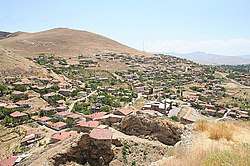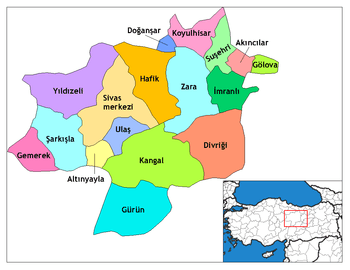Divriği
Divriği, historically known as Tephrike (Greek: Τεφρική Tephrike, Armenian: Տեւրիկ Tewrik) and formerly sometimes called Divrik, is a small town and a district of Sivas Province of Turkey. The town lies on gentle slope on the south bank of the Çaltısuyu river, a tributary of the Karasu river. The current Mayor is Hakan Gök.[3] Divriği is home of the UNESCO World Heritage Great Mosque and Hospital of Divriği.
Divriği | |
|---|---|
Town | |
 Divriği | |
 Location of Divriği within Turkey. | |
 Divriği Location of Divriği within Turkey. | |
| Coordinates: 39°22′N 38°07′E | |
| Country | |
| Region | Central Anatolia |
| Province | Sivas |
| Government | |
| • Mayor | Hakan Gök (CHP) |
| Area | |
| • District | 2,723.77 km2 (1,051.65 sq mi) |
| Population (2012)[2] | |
| • Urban | 10,824 |
| • District | 16,272 |
| • District density | 6.0/km2 (15/sq mi) |
| Time zone | UTC+2 (EET) |
| • Summer (DST) | UTC+3 (EEST) |
| Website | www.divrigi.bel.tr |
History
.jpg)
During the Byzantine period Tephrike was an important stronghold for the dualist heretic Armenian Paulicians. Their leader, Karbeas, founded it ca. 850, and the Paulicians fortified it and used it as refuge and the capital of their state during the ninth century.[4] It was captured by the Byzantine Empire during the reign of Emperor Basil I and was temporarily named Leontokome (after Emperor Leo VI) and made into a thema.[4] In the early eleventh century, the town was part of the territory given to the Armenian king Seneqerim-Hovhannes of Vaspurakan in exchange for his lands in Vaspurakan.[4] Around 1071, after the battle of Manzikert, the area was conquered by a Turkmen warrior named Mengujek Ghazi. A medieval castle, with remains mostly from the thirteenth century, is situated on top of a steep hill overlooking the town.
In 1228–29, while Divriği was under the rule of the Mengujekids, the local ruler Ahmedshah commissioned a mosque (Divriği Great Mosque - Divriği Ulu Camii in Turkish) which stands mostly intact. The mosque, along with the adjoining hospital (Darüşşifa), are on UNESCO's World Heritage List by virtue of the exquisite carvings and architecture of both buildings.[5] The complex is considered to be one of the most important works of architecture in Anatolia. The geometrical and floral patterned reliefs found on the main door in particular attract great interest.
Sport
DÇ Divriği is a football club from the Divriği Municipality of Sivas. At the 2008–09 season, they competed in the TFF Third League 4th group. Unfortunately, DÇ Divriği could not be saved from the relegation zone until spring.
Notable people
See also
- Divriği Great Mosque
- Mengujekids
References
- "Area of regions (including lakes), km²". Regional Statistics Database. Turkish Statistical Institute. 2002. Retrieved 2013-03-05.
- "Population of province/district centers and towns/villages by districts - 2012". Address Based Population Registration System (ABPRS) Database. Turkish Statistical Institute. Retrieved 2013-02-27.
- Şafak, Yeni (2019-05-11). "Sivas Divriği Seçim Sonuçları – Divriği Yerel Seçim Sonuçları". Yeni Şafak (in Turkish). Retrieved 2019-11-05.
- Foss, Clive. "Tephrike". Oxford Dictionary of Byzantium. vol. 3. Oxford: Oxford University Press, p. 2025.
- Centre, UNESCO World Heritage. "Great Mosque and Hospital of Divriği". UNESCO World Heritage Centre. Retrieved 2019-11-05.
Sources
- (Book cover) Oktay Aslanapa (1991). Anadolu'da ilk Türk mimarisi: Başlangıcı ve gelişmesi (Early Turkish architecture in Anatolia: Beginnings and development) (in Turkish). AKM Publications, Ankara. ISBN 978-975-16-0264-0.
External links

- Divriği Great Mosque And Hospital
- "UNESCO file: Divriği Great Mosque and Hospital". UNESCO.
- "Fact sheet: Great Mosque and Hospital of Divriği". Archnet. Archived from the original on 2006-02-26.
- İbrahim Shaikh. "The Miracle of Divriği (full text and photos)". The International Society for the History of Islamic Medicine.
- Mustafa Güler, İlknur Aktuğ Kolay. "12. yüzyıl Anadolu Türk Camileri (12th century Turkish mosques in Anatolia)" (PDF) (in Turkish). Istanbul Technical University Magazine (İtüdergi). Archived from the original (PDF) on 2007-07-04.